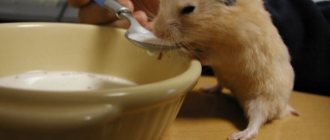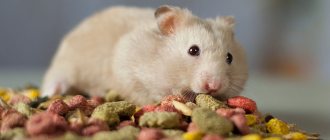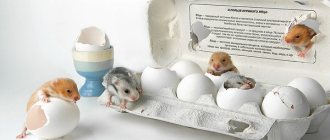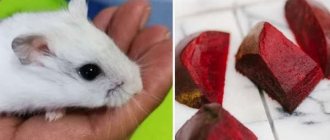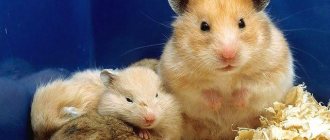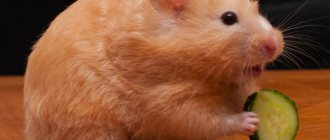Even a non-professional breeder can breed wonderful fluffy hamsters. Before you become the owner of this little friend, you need to decide on the breed, since this determines how much the hamster weighs.
The parameters of a pet are very important, as they affect such nuances as:
- The size of the future home.
- Accessories for the cage, such as a wheel, mazes and more.
- Amount of feed consumed.
- The presence or absence of neighbors.
Reproduction and raising of offspring
Hamsters become sexually mature very early. Actually, both females and males are ready for procreation, reaching two months of age. The breeding season for these animals lasts from April to October. During the winter months, hamsters become inactive and practically do not crawl out of their burrows, eating accumulated reserves. But zoologists sometimes record cases of cubs being born in December, and this usually happens during an abnormally warm and snowless winter.
Unlike their wild counterparts, domestic hamsters breed all year round, since when kept in an apartment, their home always has a comfortable temperature and enough food.
Features of the mating season
As already mentioned, in their natural environment, hamsters lead a solitary lifestyle. They do not form strong mating unions, although some males have a kind of personal “harem” consisting of 3-5 females. True, he lives in different burrows, but the females live in the controlled territory of their “husband,” and he jealously protects them from the encroachments of foreign males.
Rules for caring for a pregnant hamster
During this important period for the owner and the pet, peace is important for the female. Once you are sure that pregnancy has occurred, you should move the cage to a quiet place and provide the hamster with materials for building a nest - paper towels. The animal's house should be cleaned regularly and thoroughly, because... the expectant mother will stock up on food that may spoil.
You can only pick up a pet as a last resort, so as not to harm the pet. You should wear gloves when doing this. During pregnancy, the hamster becomes aggressive and is capable of biting its owner.
Nutrition
In order for a female to bear healthy babies, she needs to be provided with the right diet, including calcium, protein foods and vitamins. The menu should include the following products:
- eggs;
- cottage cheese;
- vegetables;
- chicken meat;
- juicy greens;
- cereal seeds.
During pregnancy, the female should be fed nutritious food.
You should be careful with green food so as not to provoke diarrhea in your pet, but in small quantities they are vital.
Perishable food should not be given, because... the female will make food reserves from them, which will further contribute to the development of infection.
Cleaning the cage
5 days before birth, the cage must be thoroughly cleaned and disinfected. At the same time, you should not touch the female or the nest - a foreign odor may remain on it, which will cause stress in the rodent, and the mother will eat the newborn cubs.
Solo content or in company
It is possible to keep 2 animals of different sexes together if they belong to the Campbell breed. Sometimes it is possible for Djungarians to live together, but this is rather an exception to the rule. Experts recommend keeping a pregnant female alone to increase the chances of getting healthy offspring.
It is important to monitor your hamster closely. If during the period of bearing the cubs she lost weight, then this is a clear sign that the rodent got sick or her children died. In the room where the animal lives, drafts and cold should be excluded.
Pregnant females should be kept alone.
Average size and weight
Taking into account the large number of species of hamsters, it would be incorrect to talk about the average size of these animals. Thus, even according to the generally accepted classification, the subfamily Cricetinae contains large, medium and dwarf varieties.
The most striking representative of the first group is the already mentioned common hamster (Cricetus cricetus), the second, in addition to the widespread Syrian, also includes Newton's, Radde's, and Brandt's hamsters. And finally, dwarf breeds are dwarf hamsters, Campbell's, Roborovsky's hamsters and many others.
Thus, it makes sense to present summary data on how much a pet of a particular breed should weigh and what size it can grow to in the form of a table:
Features of feeding
In the wild, hamsters feed on plant seeds, nuts, herbs, and gnaw branches of bushes. Sometimes they eat insects or their larvae. At home, the rodent is fed grain mixtures, which include:
- millet;
- barley;
- millet;
- lentils;
- buckwheat;
- peanut;
- sunflower seeds;
- pumpkin seeds;
- raisin.
You can and should give your rodent wet food. These are vegetables - carrots, cucumber, cauliflower, broccoli, zucchini. A sour apple is allowed as a fruit. Domestic hamsters love to eat grass - dandelion leaves, young nettles, plantain.
Once a week you can offer your pet boiled chicken breast and an egg without adding salt.
Attention! To prevent a decorative hamster from having problems with teeth, solid treats are introduced into the animal’s diet - branches of fruit trees and shrubs - cherries, apricots, raspberries, currants.
There should be a lick stone in the cage. With its help, the rodent will compensate for the lack of minerals in the body. It is important to ensure that the drinking bowl is filled with clean water.
Why do you need to record your hamster's weight?
There are several points that the owner needs to pay attention to in order to notice health problems in the pet in time; one of the most important indicators is the pet’s weight. Knowing the usual weight of your adult animal, you can quickly determine the following cases:
Pregnant female
Rapid weight gain begins 7-10 days after fertilization, which allows an attentive owner to monitor the successful course of pregnancy, introduce foods rich in vitamins and protein into the expectant mother’s diet in a timely manner, and increase the amount of drinking water.
Also, the owner will promptly move the animal into a separate cage with the necessary building material for the nest.
Complications during pregnancy
Knowing the initial and current weight of the female, you can find out the approximate date of birth and promptly seek help from a veterinarian if the situation requires it. For example, a decrease in the weight of a pregnant female indicates intrauterine fetal death or that childbirth occurred, but the hamster ate the babies.
Animal diseases
Weight gain and an enlarged abdomen may be a sign of digestive problems, ascites, heart disease or cancer.
Poor nutrition
A gradual weight gain in an adult, mature animal may be a signal that it is time to put your pet on a diet, otherwise obesity cannot be avoided. Reducing the amount of grains and nuts in the diet and increasing the proportion of vegetables and herbs will help avoid problems such as blockage of blood vessels, cardiac arrest and digestive problems.
In addition to nutrition, you will also have to adjust the motor mode: provide the pet with the opportunity to walk outside the cage, purchase a running wheel.
What does a hamster's weight change affect?
Siberian hamster
The Siberian hamster can be found in nature; it lives in Siberia, hence its name.
They are very reminiscent of Djungarian hamsters, differing only in the color of their fur. The Siberian has a gray color, and in winter the animal’s coat becomes completely white. This is especially interesting to observe when kept at home.
The average weight of a pet reaches 40-50 grams, and these animals grow no more than 8 cm in size. To keep a Siberian hamster, a cage the same as that of a Djungarian pet is suitable.
siberian hamster
Which hamster is better to get - Djungarian or Syrian?
| Size | Up to 10 cm. Weight – 40 g. | Up to 18 cm, that is, almost 2 times more. Weight – 100-140 g. |
| Color | Mostly gray, there are albinos with light fur and red eyes. | Most often golden, but there are white, black and brown. |
| One or two? | They are very sociable and live in friendly families in nature. Feel free to have several furry babies, but always have a second cage or carrier ready. No one is immune from quarrels! | Prefers to live alone and needs a separate territory. Couples rarely get along. |
| Cell | Despite its modest size, it needs spacious housing. Due to the high level of activity, a wheel and maze are required. | Also loves space. It is advisable to equip the cage with a wheel. |
| Smell | It is characterized by cleanliness. It has a moderate odor, characteristic of all rodents. Cleaning once a week is enough. | It has a sharp, specific smell, so the cage requires more frequent cleaning - 2-3 times a week. |
| Taming | Wild, difficult to get used to being handled, reacts poorly to affection. | Adapts faster to a new place and owner, loves to be scratched. |
| Health Features | He is prone to diabetes, so you should not feed him sweet fruits and dried fruits. | Given proper nutrition, he rarely gets sick. |
| Lifespan | With proper care - 3 years. It is a long-liver among this species of rodents. | Usually 2-2.5 years. |
What to feed a hamster
The majority of the diet should be prepared food What Can Hamsters Eat? , for example crumbly mixtures. They contain grains, seeds and dried vegetables. The disadvantage is that hamsters pick out the tasty morsels. Less tasty but healthy additives often remain in the bowl. Therefore, you need to make sure that the animal finishes everything. If you have no time to control your diet, it is better to choose granulated food.
Hamsters can also be given human food, but its amount should not exceed 10% of the diet. Here are examples of safe products:
- Vegetables : broccoli, carrots, cauliflower, cucumber, potatoes (cooked), spinach, cabbage.
- Berries : grapes, blueberries, strawberries.
- Legumes : young beans and peas, dry or steamed lentils, unsalted peanuts.
- Fruits : apples (without seeds), bananas.
Animals are also sometimes given hay, dandelion leaves, crickets and mealworms.
You cannot feed your hamster citrus fruits, raw potatoes, apple seeds, dry peas, onions, garlic, almonds, sweet and salty foods.
What to feed your Syrian hamster at home
The rodent's diet should consist of light foods rich in nutrients and microelements. You need to feed your Syrian hamster in the morning and evening. The Syrian rodent's diet should be a combination of dry and succulent food, for example, give it some herbs and grain food. The food bowl should be kept in the cage at all times, as many of these hamsters are nocturnal. Here's what food you can give him:
- carrot;
- sunflower or pumpkin seeds;
- apples;
- pumpkin pulp;
- persimmon;
- pears;
- apples;
- zucchini;
- greenery.
- 7 signs of advertising a quack medicine
- How to refuse a Rostelecom home phone - procedure for terminating the contract and package of documents
- Why do smokers age quickly?
Reproduction
The most suitable age for mating of a Syrian female is from 4 to 6 months. If pregnancy occurs earlier, then in most cases the female is unable to carry her offspring to term. But the male is ready to mate from the age of five weeks and can produce offspring throughout his life. Reproduction of Syrian hamsters should be carried out during the period when the female hamster comes into heat, because otherwise the individuals will simply fight. If the female is favorable to her partner, then the mating will proceed normally. This process lasts approximately 15-20 minutes.
The female does not always become pregnant the first time. If this does not happen, then the process of breeding Syrian rodents must be repeated until you achieve a positive result. If after 4-5 days the female is not in heat (the presence of which can be recognized by a pronounced odor and the presence of discharge), then this means that she has become pregnant. The gestation process lasts 16-18 days. To give birth, she goes into the so-called nest she created from twigs and pieces of paper. On average, hamsters give birth to 7 to 10 babies.
Diseases
With proper nutrition and care, Syrian hamsters practically do not get sick. Common ailments of this species of rodent include colds and stomach upset. It is easy to identify a sick animal: the hamster becomes inactive, eats practically nothing and loses weight. He is not interested in anything, does not want to play. Sick hamsters go to a secluded, quiet place, away from their relatives, and lie there until they recover.
Diseases that may occur in this rodent include conjunctivitis, diabetes, cystitis, dental problems, baldness, abscesses, eczema, abscesses, herpes, inflammation of the cheek pouches, trichomoniasis, tumors, heart disease, and pneumonia. One of the most dangerous hamster diseases is “wet tail,” in which the back and tail of the animal become wet. If your pet is sick, you need to take the following measures:
- Take your hamster to the vet. You only need to take the animal out of the cage while wearing gloves.
- Disinfect the cage and ventilate it well. Move other roommates to another location for a while.
- Ventilate the cage for several days, only after that put the hamsters back in it.
How to weigh a hamster?
A hamster is a nimble animal that is difficult to keep in one place for a long time. If the pet is disobedient and untamed, you will have to cheat to find out the weight of the hamster. Use these short instructions to help you quickly measure your khoma without causing discomfort.
- Get your electronic scales ready. A regular kitchen scale will do. Their accuracy should be sufficient to weigh a light hamster.
- Take a container that matches the size of the animal. Without such an “accessory,” the animal can easily escape and it will not be possible to measure its “parameters.” The container will help contain the animal for at least a few minutes. You can use a regular glass or bowl. Before weighing, the tare weight should be reset to zero.
- To help your pet sit still, place a couple of sunflower seeds or another light treat in the container. This will interest the animal, and it will be calm for a while.
After you manage to measure the khoma, the result needs to be written down. This will help control weight loss or gain. Rapid weight loss indicates the presence of diseases. Weight control is also helpful when changing your diet or diet. This will ensure that your pet is eating new food and not hiding it in corners. A healthy hamster should weigh as much as is normal for an animal of its breed and age.
Article on the topic: Can hamsters swim and what are the dangers of water?
Cost of Djungarian hamsters
When buying a Djungarian hamster, it is advisable to pay attention to factors such as:
- Pet's age. The hamster should be about 5-6 weeks old.
- Character of behavior. The animal should not be too apathetic and lethargic, or overly excited or nervous.
- Health. His state of health visually should not raise the slightest doubt.
- Wool cover. It should be dry and clean, without signs of bald spots or mechanical damage.
- The condition of the eyes, which should be clean, without traces of various discharges.
- The condition of the nasal cavity, which also should not have traces of various secretions.
- The condition of the fur around the anus should be characterized as clean and dry.
If a person has little experience, then it is quite difficult to distinguish the sex of very young individuals. This is true even for breeders. It is better to know for yourself how to distinguish a male from a female. Similar animals can be bought for 250-350 rubles, regardless of gender. If hamsters have a rather rare color, then the cost of such individuals is slightly higher.
Signs of pregnancy in a hamster
You can find out about pregnancy by changes in behavior:
- increased appetite;
- increasing food supplies;
- decline in activity;
- drowsiness;
- preparation and arrangement of the nest.
These signs appear 10-12 days after mating.
Appearance
You can also identify a pregnant animal by characteristic external changes:
- estrus stops;
- on the 7th day the belly begins to grow;
- nipples become pink and swollen;
- at 10 days the hamster sharply gains weight.
Visible signs of pregnancy in hamsters appear after about 10 days.
Wild (common) hamster
Representatives of this breed are distinguished by their large size compared to other breeds. One tail of an ordinary hamster reaches about 8 centimeters, and its height is about 30 cm. Such hamsters require special maintenance; the home must be spacious to be able to install a labyrinth or several rooms with storage rooms.
They are very rarely kept at home due to the difficulty of providing the necessary housing. These animals are very thrifty; in the wild, their reserves can exceed 15 kg.
Character and lifestyle
By their nature, hamsters are loners, aggressive against anyone who encroaches on their territory. They protect their possessions up to 10-12 hectares in size. The size of the enemy does not matter; there are known cases of rodent attacks on large dogs.
If related rodents run away from meeting a person, steppe hamsters may attack. Rodent bites are painful, can cause infection with many diseases, and leave lacerations.
Ruthlessness manifests itself even towards its own individuals. The weaker ones will not escape alive from their strong and toothy relatives if they consider them an enemy during mating time or simply notice an unwanted guest near their reserves. The activity of the animals manifests itself at twilight. Hamsters are nocturnal animals . During the day they hide in holes, gaining strength for fearless hunting.
Deep dwellings are located 2-2 meters underground. If the soil allows, the hamster will go as deep as possible into the soil. The living chamber is equipped with three exits: two “doors” for ease of movement, and the third leads to a pantry with supplies for the animals’ winter life.
The hamster uses the accumulated food only during hungry, frosty times and at the beginning of spring. In other seasons, food consists of food from the external environment. Above the burrows there are always dug piles of earth, sprinkled with grain husks. If cobwebs have accumulated at the entrance, then the home is abandoned; hamsters keep the houses clean.
Not all hamsters hibernate; some species even turn white so that their forays into the snow cover are unnoticeable. Those who wait out harsh weather in shallow sleep periodically stay awake to refresh themselves with accumulated reserves. When the earth begins to warm up, in February, March or early April, it is time for the final awakening.
But before leaving completely, the hamster will still feast on supplies, gain strength, and then open the entrances and exits of the hole. The males emerge from the burrows first, and the females a little later.
Peaceful relations between them are established only during the marriage period, otherwise they exist on equal terms. Hamsters' ability to swim well is amazing. They inflate their cheek pouches like a life jacket that keeps them afloat.
Body structure
Hamsters look harmonious and proportional.
The structure of their body is characterized by the following features:
Body type Dense, well-knit Body length (excluding tail) 5–35 cm Weight 30–700 grams Head Not very large, round, on the muzzle there are hard vibrissae (“whiskers”) of a dark color Ears Small, round in shape, auricles on the outside covered with dark hairs, thinner than the main fur. Eyes Small. Tail Short, no more than 10 mm. It is thick at the base, then sharply tapers into a triangle shape. May be hairless or covered with coarse and short hairs. Feet: Small but strong, with wide hands and feet. The toes have hard and strong claws, with the help of which the animal is able to dig holes even in very dense soils. Some species have bare limbs, others are covered with hair (this group is called “hair-footed”) Fur is thick and soft Teeth Sharp and strong. Teeth have no roots, but they grow throughout the rodent’s life.
A distinctive feature of hamsters is the presence of special muscle cavities located in the lateral parts from the inner surface of the cheeks to the neck and very shoulders. These are the so-called cheek (or cheek) bags. For the rodent, they act as a kind of container into which the animal loads large supplies of food and then transfers them to the hole, where a stationary storage facility has already been installed, allowing the animal to be provided with food throughout the winter.
The presence of cheek pouches can make a hamster's life much easier. In addition to carrying food, the animal can use this feature of its physique for more original purposes, for example, swimming. The animal fills the volumetric cavity in the upper part of its body with air and thus receives an excellent “life preserver.”
Did you know? Cheek pouches are found not only in hamsters, but also in other rodents, including ground squirrels, chipmunks, harelips, pouched rats, and gophers. It is interesting that many species of monkeys have the same formations, but vultures, wolves and coyotes in the process of evolution have learned to use a safer place to transport food - their own stomach.
Appearance of hamsters
From the point of view of biological classification, hamsters belong to the rodent order, mouse-like suborder, and hamster family. By the way, this same family, united by the common Latin name Cricetidae, includes the well-known voles, as well as lemmings, muskrats and about six dozen other animals.
The subfamily of hamsters includes 7 genera (according to other classifications - 6) and has about two dozen species, not counting ornamental breeds bred through selection, including crossing.
Representatives of these species can differ quite greatly from each other in size, color, and appearance, but the “average” hamster is a small rodent, very similar to a mouse, but has a slightly denser build, a rounded rather than sharp muzzle with a well-shaped cheeks that stand out on her, as well as a short, almost invisible tail.
Did you know? In the tropical forests of Central America live small nocturnal animals with a long, mouse-like tail. These are Tylomyinae climbing hamsters, a rather rare and little-studied species of the closest relatives of the known inhabitants of the steppes.
The fur color of hamsters can be different, either monochromatic or contrasting. In general, the coloring of these animals directly depends not so much on the breed, but on the specific habitat. Inhabitants of deserts and semi-deserts have golden or light gray fur, almost indistinguishable in shade in different parts of the body.
This allows the animals not to stand out against the background of the sand and, thus, to be less noticeable to natural enemies, of which small rodents have a lot both in the air and on the ground. For the same reason, forest hamsters are usually brown or gray, and species living in the mountains are black or brown.
The white color in hamsters is usually the result of a genetic abnormality associated with the absence of the pigment responsible for the color of the fur - melanin (this phenomenon is called albinism, it is characteristic of many animals and even plants).
However, rodents living in the northern regions experience the so-called seasonal molt twice a year, during which, in addition to the thickness of the fur, its color also changes: in winter it becomes white, and in summer it darkens again. This amazing natural phenomenon is also designed to perform the task of camouflage.
The hamster's belly is usually slightly lighter than the back, and there is often a wide longitudinal stripe of a darker color on the back. The exception is the common hamster, colored according to the principle “black bottom, brown top.” In the front part of the body on the sides of animals of this species there are large light spots separated by a red area; the same decorations are found on the head behind the ears. There are also completely black hamsters, as well as two-colored individuals with white spots on the neck and limbs.
Important! Scientists have noted a characteristic pattern, the reasons for which are not yet entirely clear: the color of hamsters’ fur is darker the further north the animal roams, but the size of the rodent increases as it moves to the east and south.
Interesting facts and myths
In ancient times, hamsters were associated with evil spirits and witchcraft.
A hamster is not a toy, but a pet that requires attention and proper care.
Now they are shrouded in completely different myths:
- These are living toys. A hamster should not be considered a toy. It requires care and respect. The animal can be tamed, but it will take effort.
- It is impossible to get rid of the cage smell. If the filler is replaced in a timely manner, there will be no unpleasant odors. The hamster is clean.
- The pet does not need water. This is wrong. Without drinking water, the animal will die.
Interesting Facts:
- The animals are used in laboratory research. They are susceptible to human viruses and have a similar tooth structure to ours.
- Matriarchy reigns among rodents of this species. The female is larger than the male and decides who will be the father of the offspring.
- In England there is a club of golden hamster lovers, which publishes its own newspaper and regularly selects a hamster of the month.
How does childbirth proceed?
On the last day of pregnancy, the hamster does not eat anything and almost never leaves the house, except to drink. Cubs are born at night. The female takes a comfortable position - sits on the sacrum area and pulls the babies out of the birth canal with her teeth. Little hamsters come out one after another at intervals of 5 minutes.
The average duration of labor is from 40 minutes to an hour.
The new mother ruptures the amniotic sac and gnaws the umbilical cord. Next, she licks the children and feeds them milk. Hamsters are born completely helpless. Their bodies are naked, their eyes and ears are closed.
All that is available to newborn babies is their sense of smell. Thanks to their sense of smell, they can find a source of nutrition - the mother's nipple.
The body length of a newborn rodent does not exceed 1.5 cm. The hamster weighs about 2 g. Its skin is pink, so thin that internal organs are visible through it.

